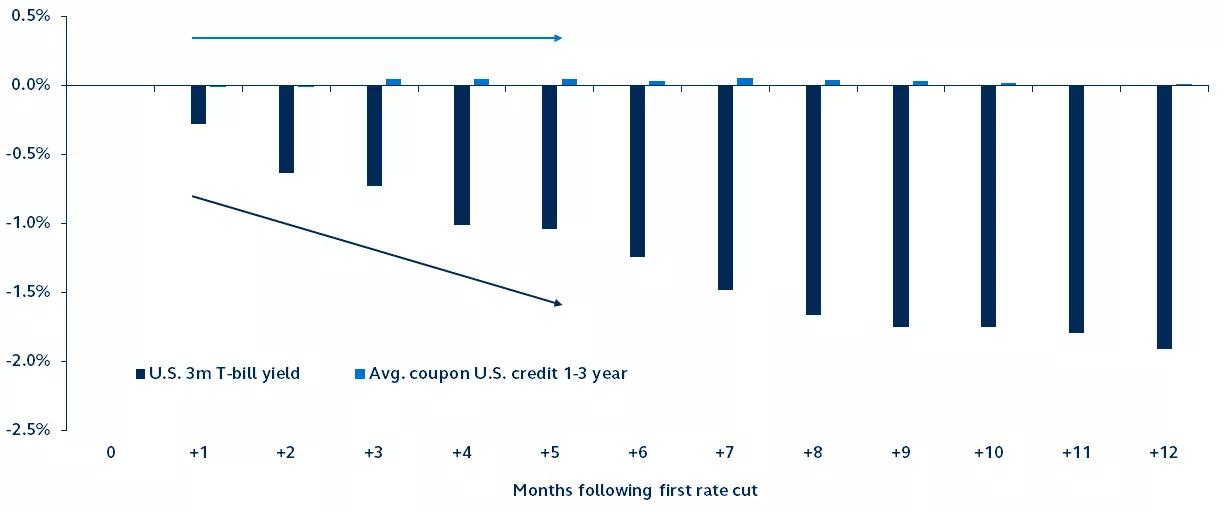In the face of impending Federal Reserve rate cuts, investors may want to consider extending duration from Treasury bills to short-term bonds. Surprisingly, the coupon on short-term bonds does not fall after the Fed begins cutting rates, whereas the yield on 3-month U.S. Treasury bills drops significantly.

Change in 3-month T-bill yield versus short term bond average coupon following first rate cut
Average per month following Fed rate cut, since 1982

With Federal Reserve policy rate reductions on the horizon, an intriguing divergence is emerging between money market funds and short-term bonds. While anticipated rate cuts suggest a downward trajectory for money market yields, short-term bonds present a contrasting scenario—an expected increase in coupons.
During the previous six Fed rate reduction cycles, the average coupon on short-term bonds saw a marginal increase of 1 basis point (bp) twelve months post-cut. This starkly contrasts the 3-month U.S. Treasury bills, which experienced a substantial drop of 119 bps in yield over the same period. The counterintuitive movement in short-term bonds becomes more pronounced when their average dollar price is below par, a situation last observed in 1984. Following the Fed's cut that year, the average coupon on short-term bonds increased by 22 bps, whereas the yield on 3-month T-bills plummeted by 318 bps.
At the end of February, the average dollar price on the U.S. Credit 1-3 Year Index stood at $96.46. As short-term bonds pull-to-par and mature, new bonds will be issued with higher coupons than those maturing, increasing the average coupon on the portfolio— even if the Fed is cutting rates.
Despite the downward trajectory of T-bill yields following Fed cuts, the coupon rates on short-term bond funds hold upward potential, offering a compelling case for extending duration to short-term bonds during the volatile period ahead.
Investing involves risk, including possible loss of principal. Past performance is no guarantee of future results and should not be relied upon to make an investment decision.
The information presented has been derived from sources believed to be accurate; however, we do not independently verify or guarantee its accuracy or validity. Any reference to a specific investment or security does not constitute a recommendation to buy, sell, or hold such investment or security, and does not take account of any investor’s investment objectives or financial situation and should not be construed as specific investment advice, a recommendation, or be relied on in any way as a guarantee, promise, forecast or prediction of future events regarding an investment or the markets in general. The opinions and predictions expressed are subject to change without prior notice.
Principal Funds, Inc. is distributed by Principal Funds Distributor, Inc.
Securities are offered through Principal Securities, Inc., 800-547-7754, Member SIPC and/or independent broker/dealers.
Principal Asset Management leads global asset management at Principal.®
For Public Distribution in the U.S. For Institutional, Professional, Qualified and/or Wholesale Investor Use only in other permitted jurisdictions as defined by local laws and regulations.
© 2024, Principal Financial Services, Inc. Principal Asset ManagementSM is a trade name of Principal Global Investors, LLC. Principal®, Principal Financial Group®, Principal Asset Management, and Principal and the logomark design are registered trademarks and service marks of Principal Financial Services, Inc., a Principal Financial Group company, in various countries around the world and may be used only with the permission of Principal Financial Services, Inc.
3450750